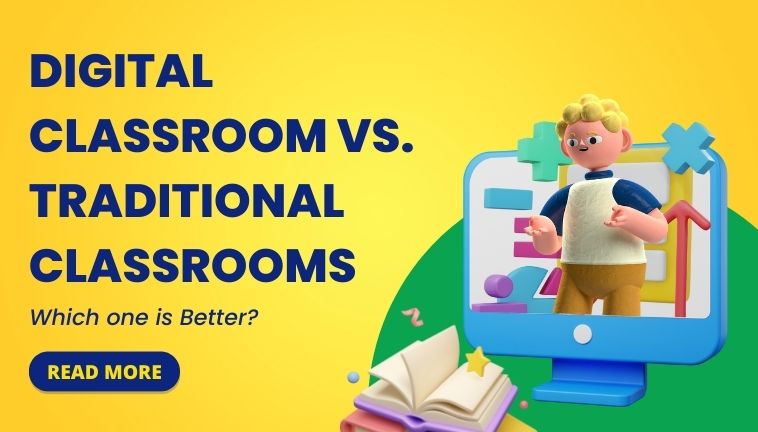Blogs
Digital Classrooms vs. Traditional Classrooms: Which one is Better?

Welcome to the digital era, where knowledge is readily accessible with just a click, and learning has entered a new realm. Traditional classrooms as compared to digital classrooms are becoming a thing of the past, replaced by the innovative landscape of eLearning, which is transforming education in unprecedented ways.
A recent study indicated that online programs in schools and colleges are growing by 56%, while their traditional counterparts saw a decrease in degree completions by 3.3%.
Let's take a closer look at the advantages and disadvantages of digital classroom compared to traditional classroom learning. We'll examine factors like flexibility and convenience versus direct interaction and socialization, to help you determine which approach might be best suited for you or your school.
What are traditional classrooms?
For centuries, traditional schooling has been the primary mode of education. These classes take place in a physical classroom with a teacher present. Students participate by attending class, taking notes, asking questions, and engaging in face-to-face discussions. Conventional classrooms offer students a structured environment that instills a sense of routine.
What are digital classrooms?
Digital classrooms are commonly conducted over the internet or using digital learning solutions for schools in the class. Students participate remotely using a computer or mobile device. These classes provide a high level of flexibility and convenience, allowing students to attend from anywhere with an internet connection.
The digital classroom stands out for its focus on interaction, cultivating collaborative communities where the distinction between teachers and students fades. In this digital word, time and place are no longer barriers, fostering an environment where learners connect using online platforms.
Why digital classrooms are better than traditional classrooms?
1. 360 degree information center
Digital classrooms serve as integrated information hubs, connecting diverse sources worldwide. Unlike traditional teaching methods with limited access to information, digital learning solutions for schools like e-books and digital libraries can be accessed from anywhere. Children can utilize information from around the globe to enrich their learning experiences.
In traditional classrooms, access to the latest information is often lacking, leading to disparities in syllabi across countries. Smart classrooms address this issue by providing equal access to information for all students globally.
2. Versatile teaching tools
One key benefit of a digital classroom is its accessibility. In traditional classrooms, students must gather in one place to learn from an instructor. Often, these lessons aren’t saved for later reference. This means that students who can't attend classes or commute might miss out, even if they're absent for just one day.
Tech-enabled classrooms address this issue by being accessible anytime, anywhere. Students can join classes using a connected device from the comfort of their homes. If they miss a lecture, they can easily catch up through recorded sessions. This also simplifies revision, as they don't need to search for content from other sources.
3. Enhanced accessibility
Every student learns at their own pace and in their own unique style. However, traditional in-person teaching often lacks the flexibility to accommodate these differences. Most classrooms focus on the group rather than the individual, leaving slower-paced learners feeling left behind, despite teachers being available after class.
Virtual classrooms offer a solution by striking a balance between structure and flexibility. Students can access content whenever they need to, allowing them to learn at their own speed. They can also review material or request additional resources if necessary. This ensures that every student grasps the concepts while staying aligned with the rest of the class.
4. Personalised and regulated learning
Every student learns at their own pace and in their own unique style. However, traditional in-person teaching often lacks the flexibility to accommodate these differences. Most classrooms focus on the group rather than the individual, leaving slower-paced learners feeling left behind, despite teachers being available after class.
Virtual classrooms offer a solution by striking a balance between structure and flexibility. Students can access content whenever they need to, allowing them to learn at their own speed. They can also review material or request additional resources if necessary. This ensures that every student grasps the concepts while staying aligned with the rest of the class.

What are some of the pitfalls of digital classrooms?
1. Meager social interaction
In online classes, social interaction may seem limited, especially in the traditional sense. You miss out on hallway chats and in-person office hours. However, that doesn’t mean you can’t interact through digital communication.
Many online classes utilize video chat platforms like Google Meet or Zoom, offer live-streamed sessions, and assign group projects. This means you can still communicate with both your instructors and peers, albeit in a different way.
2. Possibility of de-motivation
Motivation is a topic often debated when it comes to these two learning methods, as every student is unique. Some thrive on regular face-to-face interactions, finding it boosts their self-motivation. Others prefer the structure of online deadlines. For many, being surrounded by instructors and peers serves as a motivation to complete assignments or tasks.
If you're someone who responds well to personal deadlines, setting them can help keep you motivated and prevent procrastination. Creating a dedicated space for online learning, free from distractions, can also enhance your focus and motivation.
3. Risk of procrastination
Staying focused in a classroom with peers and an instructor is straightforward, but what about online learning? When learning remotely, distractions can creep in, especially if you have other tasks or are occupied with something else
In Conclusion
Both digital classrooms and traditional classroom learning come with their own set of pros and cons. Traditional classrooms allow for face-to-face interaction with teachers and classmates, while eLearning offers flexibility and convenience.
The choice between the two depends on individual preferences and requirements. However, in today's digital era, blending elements from both approaches can create a comprehensive educational experience that accommodates diverse learning styles. Regardless of the method chosen, embracing lifelong learning is essential for personal development and achievement.





